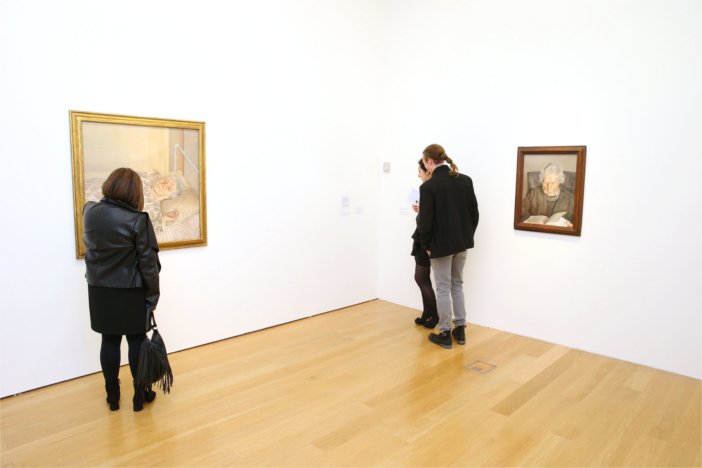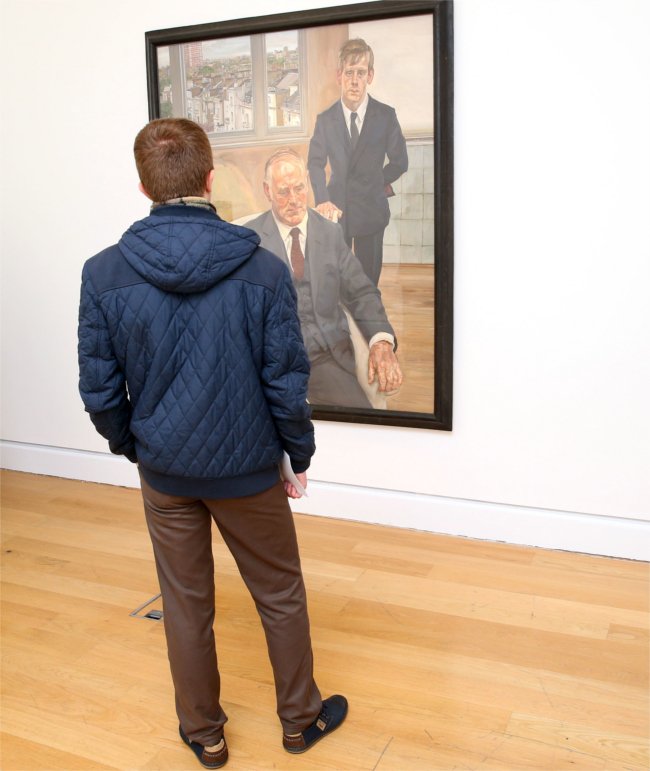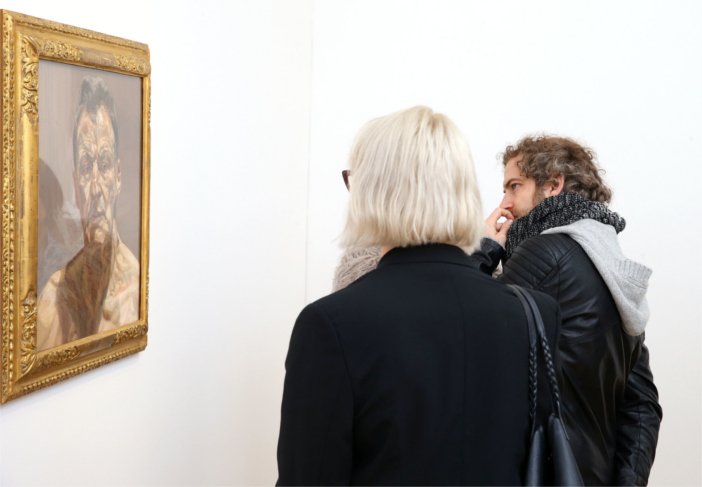‘Seeing All Head On and Askant’: Lucian Freud at IMMA
On entering the newly dubbed ‘Freud Gallery’ on IMMA’s grounds and finding yourself in the inaugural room of its first floor, you are welcomed by Lucian Freud’s portrait of his mother, helpfully called The Painter’s Mother Resting I (1976). She lies on a bed, her hands up by the metal frames in apparent bondage, cheek turned and eyes open to a slit.
The tension of the painting comes from the near photographic realism of the materials – the bunched corpuscles of the eiderdown, the flattening shape of a paisley dress, the thin strokes of the wall’s magnolia paint – with the blotched, bloated, and twisted muscles of the human body. While the man-made, inorganic materials appear unblemished and new, the corporeal woman the painting asks us to focus on radiates the diffuse folds and layers of the human body. It is a scene of supposed comfort but heightened with apprehension: the splendour of the different materials are beset by a bed frame suggestive of a hospital ward, those hands claw-like as they pinch at air, gripping nothing. At the centre, a woman’s face filled not with dread but glumly accepting a simple fact: her body is an organism to be examined.

David Sillito’s 2011 obituary to the painter begins: “Flesh; naked, unadorned, wrinkled flesh fascinated Lucian Freud”. Yet the inherent scandal of that line seems to undermine the sombre, simply unsexy approach Freud had towards the human body. A materialist in a philosophical sense, Freud used the exacting reality of his work to present his subjects and, by extension, humanity as meat not deified. The accompanying book on the exhibition contains a brief anthology of artists’ responses to Freud, and it is this visceral quality and the Nietzschean ideas it inspires that seem to boom throughout: Eileen Altfest remarks that his paintings have a “directness that borders on cruelty”. Miroslaw Balka leaves a long, list-driven question that culminates with: “[is] being a canvas, being a surface, the same as being a human body?”. Alice Maher keeps it subjective and direct: “I’m afraid his paintings make me quite ill. It’s actually a visceral reaction I have to all that bloatedness: I almost choke when I look at them”.
However, the ‘Freud Project’ is fundamentally different from the usual collections of Freud that have contribute to that reputation. There are only two oil nudes on display – one unfinished (Naked Portrait, Fragment from 2001) and the other hardly larger than the show’s free pamphlet (Annabel, 1990). The slight step from the usual path allows Freud’s other obsessions an airing; in particular, his virtuous skills in portraiture, etching, and composition. It shows in commanding fashion how Freud can be seen to converse with Rembrandt, Velasquez, and Cezanne. It presents his credentials as a Master with that all too important capital ‘M’.
This exhibition is in ways a happy reunion for two of the century’s greatest painters. Freud and Francis Bacon had first met in 1944, and would continue to have a friendship that lasted their entire careers and informed each other of how to approach painting in the latter half of the 20th century. They are also, serendipitously, deeply tied to Ireland: Bacon was born in the country and ran away from it, Freud married and painted those who had also left it (their portraits prominently feature in this exhibition). While Bacon’s donation of his studio to the Hugh Lane has been one of the perpetual highlights of Dublin’s art scene, this display of fifty works by Freud allows the two nihilistic exiles a chance to have their pronouncements considered in person within the same day.
The comparison to Bacon seems invited by the IMMA show due to their hanging of David Dawson’s photographs of Freud at work. At first glance, similarities between the artist’s studios abound: the same sulfuric yellow dominates the rooms’ lighting while a black sun of paint whirs central on both their walls. However, there is a vital difference in their studios that separates the two artists and their entire approach to answering the ‘photography’ conundrum that beset painted portraiture. In these dark spaces, they pondered what is even the point of painting when a photograph can do it all within seconds. However, it has been half a century since Kandinsky, and pure abstraction had become safe. Both burrowed into how to radicalise abstraction within the traditional forms. Both seemed to work backwards, taking the new media as their cue. Bacon would use photographs for models – scrunching the very material of the paper or polaroid and collaging the different shapes into one, breaking and confusing human integrity. His people gurn like apes and hunch like dogs, while lumps of meat appear aching to speak. These photographic scraps fill a studio really too small for anyone else.
However, in the centre of Freud’s work-space, ready to be painted is sat an actual sitter. Bridging the practices of the painter and the photographer, Freud had a human being that he encircled and conversed with throughout the mammoth sittings; a hundred sessions of around three hours each could be sunk into a single portrait. Despite the visceral and austere ideology that writhes in his paintings, Freud would ask his subjects whether they were comfortable and say that he tried ‘to impose my ideas on my sitters as little as possible’. It sounds as if he wished to catch them off-guard as a photographer would, but observe with a longevity that would outlast any deceiving trick of the light. In a rare interview with the BBC, Freud said that when it came to his sitters, “I want to do them”. He was, fundamentally, a people person.

The most dominating of Freud’s people on display is aptly named. The Big Man (1976-7), its subject an Irishman (a fellow gallery goer muttered to their friend that “he looks like a Munster man”), is a massive portrait, taking its cues from Velasquez in similarities of composition and Cezanne in the fusion of perspective. Seated in an armchair with burst-open arms, he sits wide-saddled, fingers interlaced in a series of x’s while looking presumptive with power. Yet, he is horrifically out of proportion, the aspects of his power inflated to mockery. Joyce would have called it ‘Gigantism’. The roaming perspective of the portrait, floating just above, makes the figure bottom heavy – his hands are as huge as shovels while the subject’s shrunken head is being swallowed by a girthy neck. The huge mirror gives stature and depth to the space behind him yet reflects the swirl of his bald spot. Despite the dominating pose, the foreground grows from the ballooning, formless growth of the Big Man’s crotch. The reaction to the painting rises from the gut, the posture of physical power rendered repulsive in different capacities. It is a grand example of how Freud fuses a traditional composition with an Impressionistic sense of scale seemingly to bludgeon the viewer with its materials. You can think dark, strange thoughts observing it. I started to wonder how, like a horse, you could probably guess the age of an Irishman: instead of counting the teeth, you just needed to measure its jowls.
On the opposing wall, seemingly to undercut the brutal depiction of human flesh, hangs a sister portrait, The Head of the Big Man (1975). Cut off from the body, the Big Man’s head looks mutely paternal, the eyes a pale blue. It is the face of a man enjoying a silence in company, or else being momentarily apprehended by the knowledge of responsibilities. Deeply empathetic, it forces a reconsideration of what was once shown to be grotesque by the same hand. It cajoles reconciliation.
It is important to note how Freud’s methods can deal in these sharply divisive reactions. The intensity of the gaze inflates the attention towards the flesh, and the resulting painting can either invite revolt or a deep, thorough empathy for what we, as people, actually are when you get down to the (physical) matter. The notion of divinity may be absent from these bags of meat, but that does not make them strange or soulless. There is an undeniable tenderness in his surveying. It is full of empathy and challenges the viewer: can you see this thing of flesh and not view it as different? Can you identify?
The fervent examination of Freud’s vision and its rapid prestidigitation in sentiment is perhaps the great joy of the works on display. A painting like Bella and Esther (1987-8), featuring two of the painter’s daughters, marries the same division of the two Big Man paintings onto a single canvas. The daughters are twisted into poses that appear awkward, while the room they are surrounded in is dark and stuffy, simply oppressive with decay. The girls themselves seem influenced by the atmosphere’s contagion: the sitter in the white shirt has a swollen shoulder while her face is pockmarked, the oils on the canvas crenelated into spikes and ragged grooves. It appears so scarred that the viewer must look at the painting from side on to comprehend its texture. The askew angle of the painting, with its floating skirting board in the background, is lumbering, like the point-of-view of someone mid-fall.

However, the volta comes with the girls’ poses. What at first appears to be an awkward splay of limbs reveals itself as the studied adolescent pose of aloofness and self-assurance. The more the painting is viewed, the more youthful vim appears. Even its jaunty angle suggests contemporary youth culture, particularly the promo shots for a MTV reality show from the 90’s. Being painted in 1988, that comparison is not far off, despite the heavy tradition that Freud deals in. To bury the new within trappings of the old is a consistent avenue that Freud mines, yet is almost as opaque as the harsh compassion that drives his portraiture.
His compassion may not always be so elusive or withering. On display is the gorgeous masterpiece of Double Portrait (1985-6), depicting a sitter reclining alongside a whippet. Of course, through how they mirror each other – eyes closed or covered over, the woman’s arm entangled with the dog’s forepaws – the theme of man as an animal seems to blare loudly. The mood, though, is akin to the bruised affection of Toulouse-Lautrec. The dog rests its mouth in her loose palm. This is an image of things communing, their bodies huddled in shared recuperation. Its beauty is astounding. You would be heartless to not want a whippet afterwards.
‘Recuperation’ may be too obvious a theme for Freud. When looking at artwork of the later 20th century, it is criminally tempting to read a response to the Second World War: Bacon sees humanity as fleshy abstraction, Freud as a battered animal! Yet recuperation, or how one smarts from past blows, informs these sets of paintings, especially given the consistent use of Irish-born or Irish-looking subjects. In the exhibition notes for Man with a Check Cap (1991), the study of retired boxer Mick Tobin, it’s noted how Freud’s oils seem to conjure every blow its subject must have suffered. However, that same effect is present in all of Freud’s paintings, from old woman to infant. Maybe it is a peculiarity of the Irish face that Freud enjoyed, but the exhibition is almost an essay on the Irish identity: a series of uprooted folk pose in bare Edwardian apartments, reduced and rendered as the bruised flesh of exiles dispossessed yet embedded in places and privileges that do not belong to them and will outlast them. In Two Irishmen in W11 (1984-5), a bright mocking window shows buildings spotless and eternal in the background, back-lighting its palsied subjects. The Big Man, seated again, grips the chaise’s arms and looks down in quiet despair, while his son stares blankly ahead. Behind them, two discarded canvases of the painter’s eyes match the son’s glare. All wear the finitude of life in their faces.
Freud usually started a portrait from his sitters’ eyes, yet it is his own, and their uncompromising vision, that play central in this exhibition. Freud avails of portraiture’s compositions to become a hideously observant camera. The long sessions that made his paintings conjure similarities to the early daguerreotypes whose subjects had to be strapped and manacled to keep still for the fifteen minutes it took to capture a clear image. Freud is the painterly equivalent, over time soaking his canvas with lumps of oil to match the physicality of his subject matter. Yet his camera obscura also moves. In this collection, Freud does to the portrait what Cezanne did to the still life, while also revealing the aggression of photography through paint. He also succeeds in reclaiming one of its [photography’s] most popular methods, the close-up, into a radicalised, realist tradition. His relentless eyes are all-seeing and blinded with the sensuous, noxious detail they relate, but it is fundamentally rewarding what these paintings tell us. In Reflection (Self Portrait) from 1985 he looks just as beaten as his other subjects, but carries an enduring leanness. He survives what he sees; he subsists. There is the look of the mad prophet in his wary glance. Up close you can notice how his right iris is a thickly cut square of blue. You think how it sees all head on and askance, and how valuable and necessary that is.
Image sources: IMMA Press
